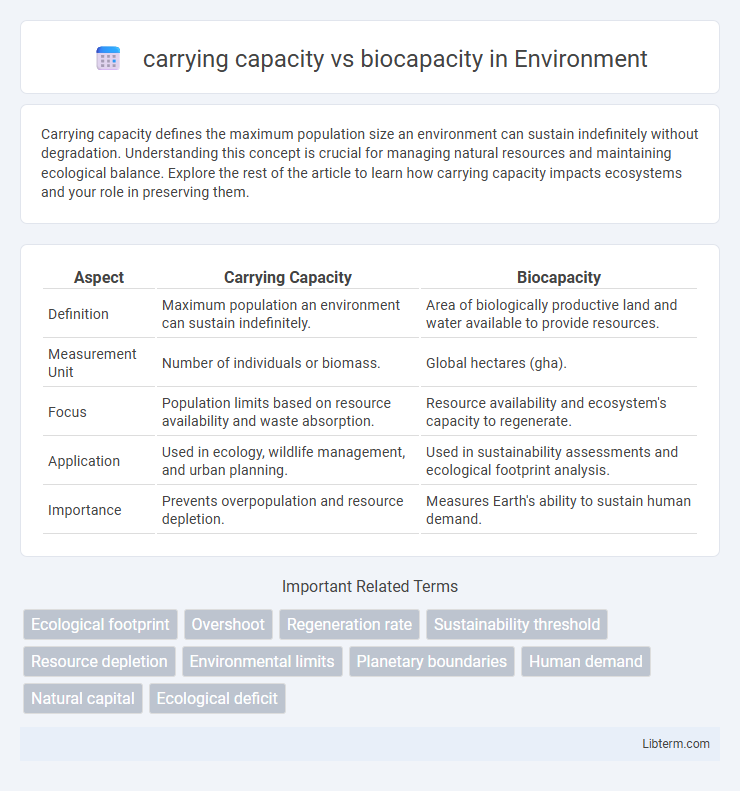Carrying capacity defines the maximum population size an environment can sustain indefinitely without degradation. Understanding this concept is crucial for managing natural resources and maintaining ecological balance. Explore the rest of the article to learn how carrying capacity impacts ecosystems and your role in preserving them.
Table of Comparison
| Aspect | Carrying Capacity | Biocapacity |
|---|---|---|
| Definition | Maximum population an environment can sustain indefinitely. | Area of biologically productive land and water available to provide resources. |
| Measurement Unit | Number of individuals or biomass. | Global hectares (gha). |
| Focus | Population limits based on resource availability and waste absorption. | Resource availability and ecosystem's capacity to regenerate. |
| Application | Used in ecology, wildlife management, and urban planning. | Used in sustainability assessments and ecological footprint analysis. |
| Importance | Prevents overpopulation and resource depletion. | Measures Earth's ability to sustain human demand. |
Definition of Carrying Capacity
Carrying capacity refers to the maximum population size of a species that an environment can sustain indefinitely without degrading natural resources or ecosystem health. It is determined by the availability of essential resources like food, water, and habitat space within a given area. Understanding carrying capacity is crucial for managing biodiversity, conserving wildlife, and planning sustainable human development.
Understanding Biocapacity
Biocapacity measures the ability of an ecosystem to regenerate resources and absorb waste, serving as a crucial indicator of ecological sustainability. It quantifies the productive area available to provide renewable resources, expressed in global hectares per person. Comparing biocapacity with carrying capacity reveals whether human demand exceeds the Earth's natural supply, highlighting potential environmental deficits or surpluses.
Key Differences Between Carrying Capacity and Biocapacity
Carrying capacity refers to the maximum population size of a species that an environment can sustain indefinitely without degradation, while biocapacity measures the productivity of an area to regenerate resources and absorb wastes. Carrying capacity is primarily concerned with population limits and resource consumption, whereas biocapacity focuses on the ecological assets available for human use. The key difference lies in carrying capacity's emphasis on population impact, contrasted with biocapacity's role as an indicator of ecological sustainability and environmental resource availability.
Measuring Carrying Capacity
Measuring carrying capacity involves analyzing the maximum population size an environment can sustain based on available resources such as water, food, and shelter. This metric is crucial for assessing ecological balance by comparing resource consumption rates with regeneration rates. In contrast, biocapacity quantifies the area of biologically productive land and water available to generate those resources and absorb wastes, providing a complementary perspective on sustainability.
Measuring Biocapacity
Measuring biocapacity involves calculating the productivity of ecological assets such as cropland, grazing land, forests, and fishing grounds to assess how much renewable natural resources an area can sustainably provide. It is quantified in global hectares (gha), representing the biologically productive area needed to supply resources and absorb wastes for a given population. Accurate biocapacity measurement is essential to compare against carrying capacity, highlighting if resource consumption exceeds ecosystem limits and informs environmental sustainability strategies.
Factors Influencing Carrying Capacity
Carrying capacity is influenced by factors such as resource availability, habitat quality, and species interactions, which determine the maximum population an environment can sustain. Human activities like deforestation, pollution, and urbanization directly affect this capacity by altering resource abundance and ecosystem health. Biocapacity measures an ecosystem's ability to regenerate resources and absorb waste, highlighting the balance needed to maintain sustainable populations within the carrying capacity limits.
Factors Affecting Biocapacity
Biocapacity depends on factors such as ecosystem productivity, land quality, and resource management practices, which directly influence the natural environment's ability to regenerate resources and absorb waste. Land degradation, deforestation, and urbanization reduce biocapacity by diminishing available productive areas, while sustainable agriculture and conservation enhance it. Biodiversity and climate conditions also play crucial roles, affecting the resilience and regenerative capacity of ecosystems.
Human Impact on Carrying Capacity and Biocapacity
Human activities significantly reduce biocapacity through deforestation, pollution, and overexploitation of resources, pushing ecosystems beyond their carrying capacity. Urbanization and industrial growth increase resource demand, often surpassing the Earth's regenerative ability and causing ecological deficits. Sustainable management of natural resources is essential to balance human impact and maintain both carrying capacity and biocapacity.
Importance for Sustainable Development
Carrying capacity defines the maximum population an environment can sustain without degradation, while biocapacity measures the ecosystem's ability to regenerate resources and absorb waste. Balancing these metrics is crucial for sustainable development, ensuring resource use does not exceed natural limits and maintaining ecosystem health. Understanding and managing carrying capacity and biocapacity supports long-term economic growth, social equity, and environmental protection.
Addressing the Balance: Solutions and Strategies
Addressing the balance between carrying capacity and biocapacity requires implementing sustainable resource management practices, such as reducing consumption rates and enhancing renewable resource efficiency. Urban planning strategies that promote green infrastructure and biodiversity conservation help maintain ecosystem health within the planet's ecological limits. Investments in technological innovation, like precision agriculture and circular economy models, support increased productivity without exceeding biocapacity thresholds.
carrying capacity Infographic

 libterm.com
libterm.com